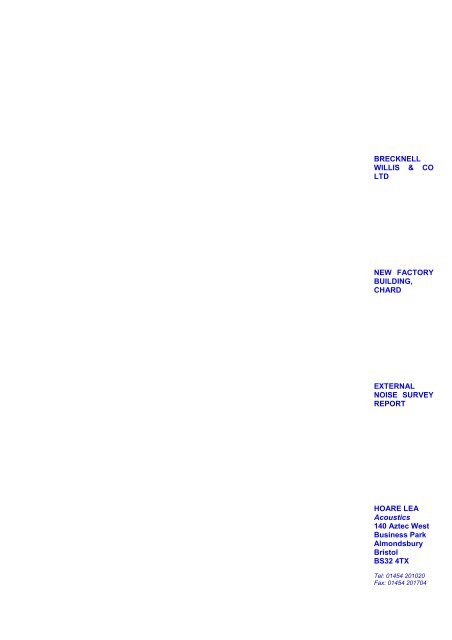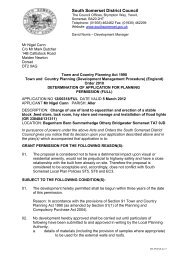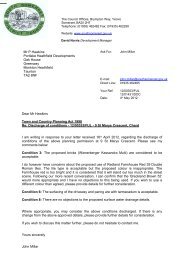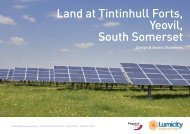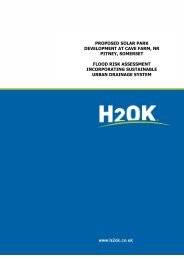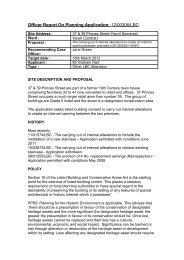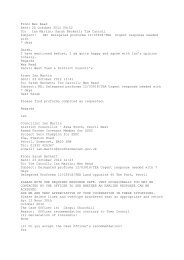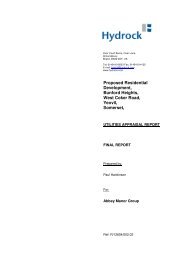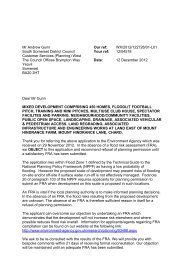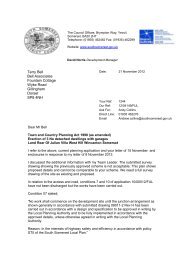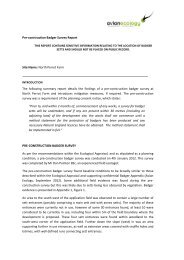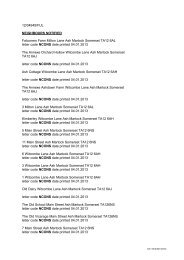BRECKNELL WILLIS & CO LTD NEW FACTORY BUILDING ...
BRECKNELL WILLIS & CO LTD NEW FACTORY BUILDING ...
BRECKNELL WILLIS & CO LTD NEW FACTORY BUILDING ...
- No tags were found...
Create successful ePaper yourself
Turn your PDF publications into a flip-book with our unique Google optimized e-Paper software.
<strong>BRECKNELL</strong><strong>WILLIS</strong> & <strong>CO</strong><strong>LTD</strong><strong>NEW</strong> <strong>FACTORY</strong><strong>BUILDING</strong>,CHARDEXTERNALNOISE SURVEYREPORTHOARE LEAAcoustics140 Aztec WestBusiness ParkAlmondsburyBristolBS32 4TXTel: 01454 201020Fax: 01454 201704
<strong>BRECKNELL</strong><strong>WILLIS</strong> & <strong>CO</strong><strong>LTD</strong><strong>NEW</strong> <strong>FACTORY</strong><strong>BUILDING</strong>,CHARDAUTHOR:ROBERT KIMBERREFREP-103546-080210-RK-2DATE: MARCH 2010EXTERNALNOISE SURVEYREPORTHOARE LEAAcoustics140 Aztec WestBusiness ParkAlmondsburyBristolBS32 4TXTel: 01454 201020Fax: 01454 201704
<strong>BRECKNELL</strong> <strong>WILLIS</strong> & <strong>CO</strong> <strong>LTD</strong><strong>NEW</strong> <strong>FACTORY</strong> <strong>BUILDING</strong>, CHARDEXTERNAL NOISE SURVEY REPORTAUDIT SHEETREVISION DESCRIPTION DATE ISSUED BY REVIEWED BYDRAFTREP-1003546-080210-RK-108/02/2010 RK KSFINALREP-1003546-080210-RK-205/03/2010 RK KSThis report is provided for the stated purposes and for the sole use of the named Client. It will beconfidential to the Client and the client’s professional advisers. Hoare Lea accepts responsibility to theClient alone that the report has been prepared with the skill, care and diligence of a competentengineer, but accepts no responsibility whatsoever to any parties other than the Client. Any suchparties rely upon the report at their own risk. Neither the whole nor any part of the report nor referenceto it may be included in any published document, circular or statement nor published in any waywithout Hoare Lea’s written approval of the form and content in which it may appear.REP-1003546-080210-RK-2.doc
<strong>BRECKNELL</strong> <strong>WILLIS</strong> & <strong>CO</strong> <strong>LTD</strong><strong>NEW</strong> <strong>FACTORY</strong> <strong>BUILDING</strong>, CHARDEXTERNAL NOISE SURVEY REPORT<strong>CO</strong>NTENTSPAGE NO1.0 INTRODUCTION 12.0 METHODOLOGY 13.0 RESULTS OF MEASUREMENTS 14.0 MECHANICAL & ELECTRICAL PLANT NOISE EMISSION LIMITS 25.0 <strong>CO</strong>NCLUSION 36.0 REFERENCES 3FIGURES1 NOISE MEASUREMENT LOCATIONS2 LOG OF NOISE LEVELS AT LOCATION 1APPENDICES1 LIST OF MEASUREMENT EQUIPMENT2 A<strong>CO</strong>USTICS TERMINOLOGYREP-1003546-080210-RK-2.doc
<strong>BRECKNELL</strong> <strong>WILLIS</strong> & <strong>CO</strong> <strong>LTD</strong><strong>NEW</strong> <strong>FACTORY</strong> <strong>BUILDING</strong>, CHARDEXTERNAL NOISE SURVEY REPORT1.0 INTRODUCTIONHoare Lea Acoustics has been appointed to conduct an external noise measurement survey to assist thePlanning Application for the proposed development of a new factory building. The development will see theformation of a new site entrance, new manufacturing and storage and distribution building.This report provides a summary of the results from the noise survey and proposes mechanical and electricalbuilding services external plant noise limits for consideration.2.0 METHODOLOGYThe existing prevalent noise levels have been measured for a sample period during a typical week. The noiselevels were measured at 1.5 m above the ground, at a location equivalent to the nearest sensitive neighbours.On Monday 18 th January 2010 a Rion NL-31 sound level meter was set up in a location equivalent to thenearest residential facades. An equivalent location were carefully chosen due to security arrangements. Thelocation of the all sound level measurements is shown in Figure 1 attached. Meteorological conditions werevaried during the measurement period; the detailed almanac gives rain observations on Wednesday 20 th andFriday 22 nd January 2010. Wind speed was observed locally to below 5 m/s. It is known that some drillingwas taking place in the development site during the early part of the week, influence from this activity hasbeen excluded from assessment. Environmental noise measurements were made in accordance with BS7445 ‘Description and measurement of environmental noise’ [1] and also satisfied measurement requirementsof BS 4142 ‘Method for Rating industrial noise affecting mixed residential and industrial areas’ [2] .Details of the sound level meter used on site are presented in Appendix 1 attached.3.0 RESULTS OF MEASUREMENTSNoise levels measured unattended at location 1 have been tabulated as daily averages in Table 1 below. TheL Aeq is logarithmically averaged over the Period T corresponding to 16 hours during daytime and 8 hoursduring night time. The L A90 given is the typical L A90, 10 min noise level measured over the period T.Day /NightDateAverageTypicalL Aeq, 16hr dBL A90, 10min dBMonday 18/01/2010 57 48Tuesday 19/01/2010 57 49Wednesday 20/01/2010 57 50Thursday 21/01/2010 57 49Friday 22/01/2010 58 50Saturday 23/01/2010 56 46Sunday 24/01/2010 54 42Monday 25/01/2010 59 49Table 1: Average Day Noise Levels measured at location 1The noise levels in Table 1 show higher values during weekdays, which is likely to be a result of less activity inthe Millfield industrial estate during the weekend of the sample measurement period.The noise levels measured at night are presented in Table 2 below.REP-1003546-080210-RK-2.doc Page 1 of 3
<strong>BRECKNELL</strong> <strong>WILLIS</strong> & <strong>CO</strong> <strong>LTD</strong><strong>NEW</strong> <strong>FACTORY</strong> <strong>BUILDING</strong>, CHARDEXTERNAL NOISE SURVEY REPORTDay /NightDateAverageTypicalL Aeq, 8hr dBL A90, 10min dBMonday night 18/01/2010 53 40Tuesday night 19/01/2010 53 40Wednesday night 20/01/2010 52 40Thursday night 21/01/2010 52 39Friday night 22/01/2010 51 38Saturday night 23/01/2010 48 37Sunday night 24/01/2010 51 39Table 2: Average Night Noise Levels measured at location 1Similarly to daytime noise levels, the average L Aeq, 8hr dB and typical L A90, 10min dB were lower during theweekends over the sample measurement period.A summary of all of the noise level measurements is presented in Table 2 below.LocationPeriod TAverageTypicalL Aeq dBL A90 dB1: Site Boundary Millfield Road Day 16 hr 57 451: Site Boundary Millfield Road Night 8 hr 51 382: Adjacent Properties Day 5 min 64 493: Site Boundary to East Day 5 min 48 31Table 3: Summary of Noise Levels at all locationsThe log of noise levels at location 1 can be seen in Figure 2 attached. At the logger location L Aeq 10min dBnoise levels vary throughout the daytime during the measurement period between 50 dB (A) and 62 dB (A).During the night time L Aeq 10min noise levels fall to between 40 dB (A) and 50 dB (A). The noise levels atlocation 1 are dominated by road traffic on Millfield Road, and there is a consistent background industrialnoise from the neighbouring estate. Further attended measurements have shown that the L Aeq 5min noiselevels adjacent to the flats on Millfield Road can be 66 dB (A) during ‘rush hour’.Noise levels across the site fall with greater distance from Millfield road. At location 3 industrial noise sourcesfrom the surrounding industrial estate contribute to the overall noise levels.4.0 MECHANICAL & ELECTRICAL PLANT NOISE EMISSION LIMITSBS 4142 provides a method of assessment which is based on the evaluation of a “rating level” for the noiseoccurring at any surrounding noise sensitive premises as a result of the source in question. The rating levelrefers to the noise in question, adjusted by the addition of a correction factor where appropriate to account fornoise features that may increase the likelihood of disturbance, such as prominent tones. A tonal correctionhas been applied to the rated noise level to account for any hums, clicks, or changes in noise levels.The likelihood of complaint is subsequently indicated by the difference between the rating level from the newsource and the existing background noise level at the reception location. The standard states that a differenceof around +10 dB or higher indicates that complaints are likely, while a difference of +5 dB is considered to beof marginal significance. A level 10 dB below the background noise is considered a positive indication thatcomplaints are unlikely.Receiver noise limits are given in Table 2 below. These are noise limits at the nearest residential receptor.REP-1003546-080210-RK-2.doc Page 2 of 3
<strong>BRECKNELL</strong> <strong>WILLIS</strong> & <strong>CO</strong> <strong>LTD</strong><strong>NEW</strong> <strong>FACTORY</strong> <strong>BUILDING</strong>, CHARDEXTERNAL NOISE SURVEY REPORTPeriod Consistent Background Noise Level Environmental Noise Criteria asmeasured at 1m from the nearestResidential façadeL A90 dBL Aeq dB07:00 - 23:00 45 4023:00 - 07:00 38 33Table 4: Mechanical and Electrical Plant limits at Millfield Road, ChardThe noise limits in Table 4 have been determined that would provide plant noise levels to be 5 dB (A) belowthe existing background noise levels. These noise limits are for the combined affect of all fixed plant to beinstalled. These levels result in an excess of -5 dB to 0 dB depending on the inclusion of a feature correction.5.0 <strong>CO</strong>NCLUSIONHoare Lea Acoustics has conducted an environmental noise survey at Millfield Road, Chard. The survey wasconducted between 18 th January 2010 and 25 th January 2010.Noise emission limits have been proposed in terms of limits at the nearest residential receptor. These limitsare specific to mechanical and electrical fixed plant only for design and planning consideration.6.0 REFERENCES1. BS 7445 ‘Description and measurement of environmental noise’ BSI 20032. BS 4142 ‘Method for Rating industrial noise affecting mixed residential and industrial areas’ BSI 1997REP-1003546-080210-RK-2.doc Page 3 of 3
<strong>BRECKNELL</strong> <strong>WILLIS</strong> & <strong>CO</strong> <strong>LTD</strong><strong>NEW</strong> <strong>FACTORY</strong> <strong>BUILDING</strong>, CHARDEXTERNAL NOISE SURVEY REPORTFIGURESREP-1003546-080210-RK-2.doc
<strong>BRECKNELL</strong> <strong>WILLIS</strong> & <strong>CO</strong> <strong>LTD</strong><strong>NEW</strong> <strong>FACTORY</strong> <strong>BUILDING</strong>, CHARDEXTERNAL NOISE SURVEY REPORTFIGURE 1: NOISE MEASUREMENT LOCATIONSREP-1003546-080210-RK-2.doc
<strong>BRECKNELL</strong> <strong>WILLIS</strong> & <strong>CO</strong> <strong>LTD</strong><strong>NEW</strong> <strong>FACTORY</strong> <strong>BUILDING</strong>, CHARDEXTERNAL NOISE SURVEY REPORTFIGURE 2: LOG OF NOISE LEVELS AT LOCATION 165LAeqLA9060555045Sound Pressure Level dB (A)403525/01/2010 12:0025/01/2010 00:0024/01/2010 12:0024/01/2010 00:0023/01/2010 12:0023/01/2010 00:0022/01/2010 12:0022/01/2010 00:0021/01/2010 12:0021/01/2010 00:0020/01/2010 12:0020/01/2010 00:0019/01/2010 12:0019/01/2010 00:0018/01/2010 12:00REP-1003546-080210-RK-2.doc
<strong>BRECKNELL</strong> <strong>WILLIS</strong> & <strong>CO</strong> <strong>LTD</strong><strong>NEW</strong> <strong>FACTORY</strong> <strong>BUILDING</strong>, CHARDEXTERNAL NOISE SURVEY REPORTAPPENDIXREP-1003546-080210-RK-2.doc
<strong>BRECKNELL</strong> <strong>WILLIS</strong> & <strong>CO</strong> <strong>LTD</strong><strong>NEW</strong> <strong>FACTORY</strong> <strong>BUILDING</strong>, CHARDEXTERNAL NOISE SURVEY REPORTAPPENDIX 1: LIST OF MEASUREMENT EQUIPMENTSound Level Meters:Rion NL-31 (Serial No. 00431027)Rion Microphone UC-53A (Serial No. 103905)Rion Preamp NH-21 (Serial No. 07194)CalibrationThe sound level meters were manually calibrated before and after measurements, and no deviations werefound to have occurred.REP-1003546-080210-RK-2.doc
<strong>BRECKNELL</strong> <strong>WILLIS</strong> & <strong>CO</strong> <strong>LTD</strong><strong>NEW</strong> <strong>FACTORY</strong> <strong>BUILDING</strong>, CHARDEXTERNAL NOISE SURVEY REPORTAPPENDIX 2: A<strong>CO</strong>USTICS TERMINOLOGYDecibel (dB)The decibel is the unit used to quantify sound pressure levels. The human ear has an approximatelylogarithmic response to acoustic pressure over a very large dynamic range (typically 20 micro-Pascal to 100Pascal’s). Therefore, a logarithmic scale is used to describe sound pressure levels and also sound intensityand power levels. The logarithms are taken to base 10. Hence an increase of 10 dB in sound pressure levelis equivalent to an increase by a factor of 10 in the sound pressure level (measured in Pascal’s). Subjectively,this increase would correspond to a doubling of the perceived loudness of sound.The Sound PressureThe Sound Pressure is the force (N) of sound on a surface area (m 2 ) perpendicular to the direction of thesound. The SI-units for the Sound Pressure are Nm -2 or Pa (Pascal).Sound is measured with microphones responding proportionally to the sound pressure - p. The power isproportional to the square of the sound pressure.The Sound Pressure LevelThe lowest sound pressure possible to hear is approximately 2x10 -5 Pa (2 ten billionths of an atmosphere). Itis therefore convenient to express the sound pressure as a logarithmic decibel scale related to this lowesthuman audible soundL p = 10 log( p 2 / p ref 2 ) = 10 log( p / p ref ) 2 = 20 log ( p / p ref ) (1)Where;L p = sound pressure level (dB)p = sound pressure (Pa)p ref = 2 x10 -5 - reference sound pressure (Pa)Doubling the sound pressure level is an increase of 6 dB.Sound Pressure Level of some common sources:SourceSound Pressure LeveldBThreshold of hearing 0Rustling leaves 20Quiet whisper 30Home 40Quiet street 50Conversation 60Inside a car 70Loud singing 80Motorcycle (10 m) 90Lawn mower (1m) 100Diesel truck (1m) 110Amplified music (1m) 120Jet plane (1m) 130REP-1003546-080210-RK-2.doc
<strong>BRECKNELL</strong> <strong>WILLIS</strong> & <strong>CO</strong> <strong>LTD</strong><strong>NEW</strong> <strong>FACTORY</strong> <strong>BUILDING</strong>, CHARDEXTERNAL NOISE SURVEY REPORTA-WeightingThe ‘A’ weighting is a correction term applied to the frequency range in order to mimic the sensitivity of thehuman ear to noise. It is generally used to obtain an overall noise level from octave or third octave bandfrequencies. An ‘A’ weighted value would be written as dB(A), or including A in the parameter term.Octave and Third Octave BandsThe human ear is sensitive to sound over a range of frequencies between approximately 20 Hz to 20 kHz andis generally more sensitive to medium and high frequencies than to low frequencies within the range. Thereare many methods of describing the frequency content of a noise. The most common methods split thefrequency range into defined bands, in which the mid-frequency is used as the band descriptor and in thecase of octave bands is double that of the band lower. For example two adjacent octave bands are 250 Hzand 500 Hz. Third octave bands provide a fine resolution by dividing each octave band into three bands. Forexample third octave bands would be 160 Hz, 250 Hz, 315 Hz for the same 250 Hz octave band.L eq,TThe L eq,T is a parameter defined as the equivalent continuous sound pressure level. Over a defined timeperiod ‘T’, it is the sound pressure level equivalent to the acoustic energy of the fluctuating sound signal. TheL eq,T can be seen to be an “average” sound pressure level over a given time period (although it is not anarithmetic average). Typically the L eq,T will be an ‘A’ weighted noise level in dB(A). It is commonly used todescribe all types of environmental noise sources.L 10,TThe L 10,T is a parameter defined as the sound pressure level exceeded for 10% of the measurement period‘T’. It is a statistical parameter and can not be directly combined to other acoustic parameters. It is generallyused to describe road traffic noise.L 90,TThe L 90,T is a parameter defined as the sound pressure level exceeded for 90% of the measurement period‘T’. It is a statistical parameter and can not be directly combined to other acoustic parameters. It is generallyused to describe the prevailing background noise level or underlying noise level.L max, TThe L max, T is maximum noise level measured during the specified period ‘T’.Free FieldA measurement taken in the free field is at least 3.5m from reflecting vertical surfaces and 1.2m from theground.FaçadeA measurement is influenced by the reflection of sound from the façade of a building within 3.5m. A façademeasurement is made 1m in front of the vertical building surface.Fast /Slow Time WeightingSound level meters can take averages using fast or slow response times.REP-1003546-080210-RK-2.doc


